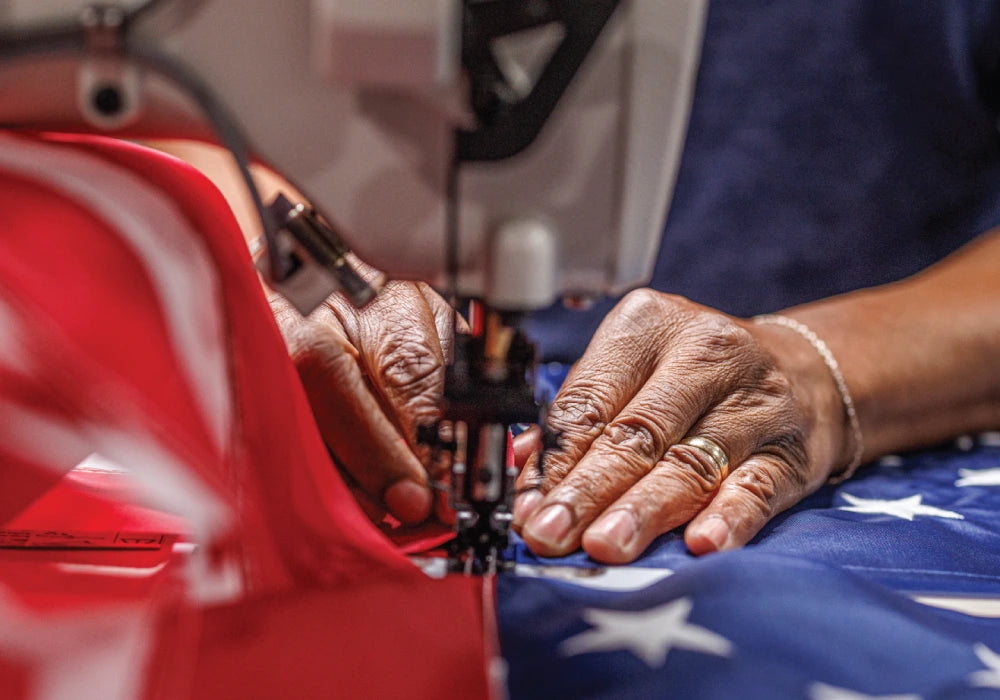The American flag symbolizes the sacrifices, values, and freedoms that define the United States. Hosting a community flag ceremony allows people to come together and reflect on what the flag represents. Whether it's Flag Day, Independence Day, or another patriotic occasion, treating the flag with dignity reminds everyone of its principles. These ceremonies inspire pride, respect, and a sense of national unity. When handled with care and proper planning, the event helps participants understand and uphold American flag customs with purpose. Making sure each step of the event is done respectfully strengthens the emotional impact for all in attendance.
Planning the Ceremony Site and Schedule
Choosing the Right Venue
The space should allow for unobstructed views of the flagpole and accommodate all guests comfortably. Parks, schoolyards, public plazas, or government buildings often work well due to their visibility and accessibility. It’s essential to consider safety, accessibility for people with disabilities, and adequate space for movement during the ceremony. A setting that naturally commands respect helps reinforce the tone of the event. In addition, hosting your American flag-raising event in a familiar and meaningful community space can boost turnout and encourage more heartfelt participation.
Preparing the Flagpole and Equipment
Check that the halyard, clips, and pulleys are working and free from wear. Secure any decorations like bunting or banners that may accompany the display. If sound equipment or podiums are needed, test everything beforehand to avoid technical issues. The condition of the pole and setup communicates your commitment to honoring the flag. Taking the time to prepare prevents delays and reflects an understanding of American flag retirement services.
Creating a U.S. Flag Ceremony Timeline
Factor in moments for reflection, musical interludes, and transitions between speakers. It’s helpful to assign a coordinator to keep the event on track, especially if you're working with multiple participants. Planning thoughtfully avoids confusion and creates a solemn, respectful atmosphere throughout the day. Opening remarks set the tone and invite guests to reflect on the purpose of the gathering. A community leader or event planner should start by extending a warm welcome. Follow this with the National Anthem and the Pledge of Allegiance, ensuring participants are guided in observance of proper conduct. Including a few short reflections or quotes about patriotism, service, and unity is appropriate. These early moments frame the ceremony’s more profound meaning and emphasize the proper display of the American flag. Keeping this portion meaningful but concise helps maintain attention while allowing time for the rest of the ceremony to unfold.
Performing the American Flag Raising and Display
How to Raise the American Flag
Raising the flag with dignity is a key moment during any patriotic event. Below is a simplified step-by-step list:
- Inspect the Flag for Cleanliness: A flag that is soiled, faded, frayed, or wrinkled may unintentionally signal neglect rather than reverence. Carefully unfold the flag on a clean, dry surface and examine it for any visible damage. Flags that have become worn should be retired following proper protocols, such as burning in a respectful manner. If the flag is only lightly wrinkled, a brief pass with a steamer or light ironing (on appropriate settings) can improve its appearance. Those responsible for the ceremony should inspect the flag with attention to detail and prepare a replacement if necessary.
- Prevent the Flag from Touching the Ground: One of the most essential rules in flag etiquette is that the American flag must never touch the ground, floor, or any surface beneath it during handling. This guideline is rooted in tradition and reflects a deep respect for the symbolism the flag carries. To avoid accidental contact, assign enough people to assist in the unfolding, attaching, and raising the flag. The person holding the flag should keep it elevated and taut, never dragging or allowing it to sag. If wind or height complicates the process, extra help should be recruited to keep the flag safely suspended. Accidental contact with the ground doesn't necessarily require flag retirement if it was unintentional and the flag remains undamaged, but avoiding the possibility entirely is the best practice.
- Assign Clear Roles to Each Participant: Typically, one person acts as the leader at the flagpole’s base, overseeing the halyard and controlling the raising motion. An assistant should manage the flag, keeping it elevated and prepared for attachment. This assistant may also help secure clips or adjust the flag’s orientation before hoisting begins. If additional individuals are involved, they can serve as escorts or manage the ceremonial elements, such as music cues or announcements.
- Create a Respectful Atmosphere for the Ceremony: As the flag is being raised, it is customary to pause all speeches, background music, or unrelated activity. Participants and spectators should be asked to stand in silence, facing the folded American flag with hats removed and hands over hearts when appropriate. If the national anthem is being played during the raising, ensure the timing aligns with the moment the flag reaches the top of the pole. Silence or reverent attention enhances the experience for everyone present, reinforcing the gravity of the occasion. Teachers, organizers, or hosts should inform attendees ahead of time about proper conduct during the flag ceremony.
- Raise the Flag Swiftly and Securely to the Top: Once preparations are complete, the flag should be raised briskly to the top of the flagpole. This swift motion symbolizes strength, determination, and respect, distinguishing the act from casual or indifferent movements. The person managing the halyard should maintain steady tension and ensure that the flag ascends without twisting or catching. The flag should then be observed briefly in its full position before any additional ceremony elements continue. Executing this step correctly underscores the intention and purpose behind the event, affirming the collective respect for the symbol flying above.
- Observe Proper Procedure for Half-Staff Display: When the flag is flown at half-staff, often to mark national mourning or solemn observances, specific protocol must be followed. Raise the flag briskly to the top of the pole, holding it there momentarily to symbolize the nation’s enduring strength. Then, carefully lower the flag to the halfway point on the pole, reflecting the occasion's somber nature. To ensure accuracy, the halfway point should be measured visually or with a pre-marked halyard. During this process, movements should be deliberate and respectful, avoiding sudden shifts or slack lines. At the conclusion of the day or ceremony, the flag must again be raised to the top before being lowered and removed. This deliberate action honors those being commemorated while preserving the integrity of the flag-raising tradition.
Each step of folding U.S. flags contributes to a meaningful ceremony that honors both the symbol and the nation it represents.
Correct Orientation and Placement of the Union
The union should always appear at the top left from the observer’s point of view. This applies whether the flag is hanging from a wall, flying on a pole, or displayed indoors. Before attaching the flag, double-check its orientation to avoid mistakes. If mounted incorrectly, the display can be viewed as disrespectful. Accuracy in this detail reflects your knowledge of American flag rules and helps set a tone of precision and pride for the rest of the ceremony. Guests will notice and appreciate your commitment to doing it right.
Lighting Requirements for Flags
If your event includes a flag display during nighttime hours, planning for proper lighting is important. According to flag etiquette, the flag should never be flown in the dark unless it is well illuminated. Use focused lighting that casts an even glow on the entire flag, avoiding harsh shadows or bright glares. Solar-powered spotlights, ground-mounted lights, or overhead fixtures are all suitable options. Make sure your lighting source is operational well before dusk. Adhering to the U.S. flag protocol regarding lighting reflects thoughtful planning and reinforces the solemn tone of your event.
American Flag Etiquette, Folding, and Ceremonial Roles
The Thirteen-Fold American Flag Folding Process
Often conducted during military funerals, patriotic events, and other solemn occasions, the thirteen-fold process turns the flag into a powerful narrative of American values. Below is a guide:
- First Fold: The first fold marks the beginning of the ceremony and is a tribute to the value of human life itself. This initial motion sets the tone for what follows, acknowledging the sacredness of life and the freedoms it supports. Whether the flag is being folded in honor of a fallen hero or during a daily flag-lowering ritual, this fold reminds observers of the lives that have been lived under its banner.
- Second Fold: The second fold signifies a belief in life beyond death, reinforcing the faith that many Americans hold in an enduring spiritual journey. This is especially meaningful in the context of a funeral or memorial, offering comfort to grieving families who believe their loved one’s soul lives on. It reflects a broader understanding that death is not the end, but a transition. The spiritual undertone of this fold adds depth to the ceremony and creates space for reflection, regardless of specific religious affiliation. It’s a reminder that the values embodied in the flag persist even as individuals pass on.
- Third Fold: The third fold pays homage to those who gave their lives in defense of the country. This includes not only members of the military but also first responders and others who died in service to the nation. It’s often seen as the most emotionally charged part of the process, connecting the flag directly to sacrifice.
- Fourth Fold: It acknowledges that freedom is not only protected by armed service but also supported through the daily efforts of ordinary citizens. Teachers, workers, parents, and volunteers all play a role in shaping the nation’s character and upholding its democratic principles. This fold celebrates civic duty, reinforcing the idea that every citizen has a responsibility to ensure liberty continues. It’s a recognition of those who build the fabric of society beyond the battlefield.
- Fifth Fold: This fold is a salute to the country itself—the republic for which the flag stands. It reflects deep respect for the institutions, principles, and freedoms that define the United States. When this fold is performed, it reaffirms allegiance to the ideals set forth in the Constitution and the commitment to uphold justice and equality. The fifth fold serves as a moment to pause and recognize the nation's enduring strength, built through unity and diversity. It transforms the flag into a representation of collective national identity.
- Sixth Fold: It symbolizes the love and loyalty carried in the hearts of Americans who pledge to the flag and the nation it represents. Whether reciting the Pledge of Allegiance or standing for the national anthem, this fold reflects the internal compass that guides people to serve, protect, and honor their country.
- Seventh Fold: Fold seven directly acknowledges the U.S. military and its role in defending the nation. It honors the courage, sacrifice, and duty of those who wear the uniform and serve in times of war and peace. This fold often resonates deeply with veterans and their families, encapsulating the risks taken and the burdens carried in the name of national security. It also serves as a call to gratitude for those currently serving and as a reminder of the importance of supporting the military community.
- Eighth Fold: The eighth fold pays tribute to mothers, especially those who have sent children into service. It acknowledges mothers' silent strength, emotional endurance, and unwavering support. This fold symbolizes the foundational role mothers play in nurturing patriotism and character in their families. In ceremonial contexts, this moment often evokes quiet reflection and heartfelt appreciation for maternal sacrifice and love, especially in families of the fallen.
- Ninth Fold: This fold represents all women—daughters, wives, sisters, leaders—who contribute to the strength of the nation. It serves to remind attendees that the American spirit is shaped not only by those in service but also by those who support, care for, and inspire others through acts of faith and kindness.
- Tenth Fold: The tenth fold is dedicated to fathers, who provide stability, protection, and moral guidance. It celebrates their influence on the next generation through quiet leadership, bold courage, or consistent presence.
- Eleventh Fold: The eleventh fold recognizes the Jewish community and its beliefs, particularly the reliance on God as a source of strength and protection. It symbolizes the inclusivity of American ideals, acknowledging the religious freedom that allows diverse faiths to coexist under one flag.
- Twelfth Fold: The twelfth fold represents the Christian faith, reflecting its influence on American culture and values. It serves as a symbolic acknowledgment of the beliefs held by many who serve, lead, and build communities across the country. Like the eleventh fold, it highlights the flag-folding process's spiritual dimension and the space for religious diversity within a shared national identity.
- Thirteenth Fold: It completes the transformation of the flag into a triangle, resembling the tricorn hats worn by patriots during the Revolutionary War. It marks the conclusion of the ceremony and encapsulates all the previous meanings into a unified, dignified presentation. This triangular form is a familiar symbol of military honor and is often presented to the family of a fallen service member. The last fold signifies unity, closure, and the eternal respect owed to the flag and all it represents.
The thirteen-fold flag ceremony weaves together a narrative of national identity, personal sacrifice, and spiritual reflection.
Guidelines for the American Flag for Caskets
Flags used in military funerals or similar memorial events must follow specific rules for size, placement, and handling. It should never touch the ground, be written on, or be tucked into the casket. During the service, the flag remains in place until it is formally removed, folded, and presented to the next of kin. If weather or space requires modification, alternate positioning must still reflect respect.
Flag ceremonies have the power to bring people together in a deeply meaningful way. These gatherings encourage pride, reflection, and unity among neighbors who may otherwise not connect daily. Hosting a flag day ceremony regularly can help build a shared identity rooted in respect for country and tradition. Consider sourcing durable, high-quality flags from the best U.S. flag store to ensure your displays uphold the highest standards. The impact isn’t just felt in the moment; it echoes in future acts of service and appreciation.






